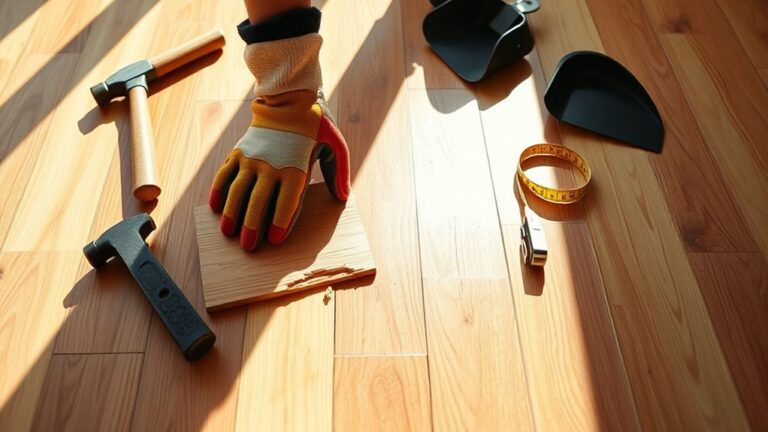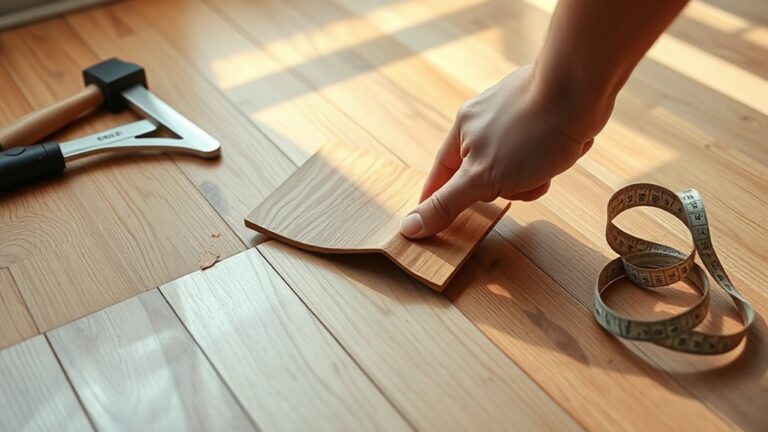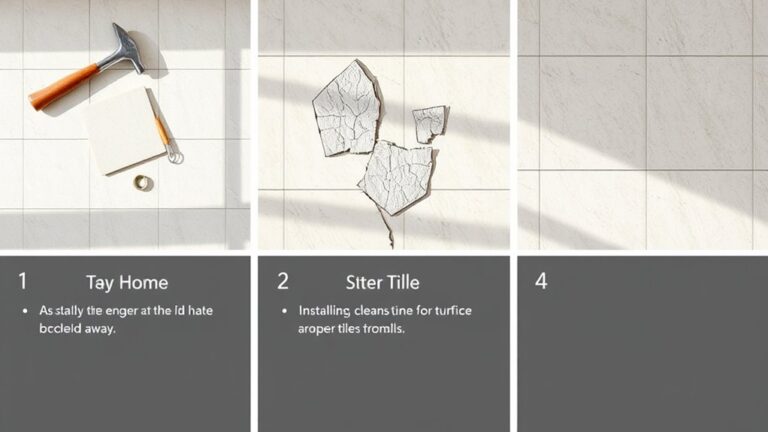Fixing uneven hardwood flooring starts with identifying the cause, like moisture damage or foundation shifts. For minor issues, you can sand down high spots or use shims to raise low areas. If the problem is more significant, consider sistering joists for support or using a self-leveling underlayment to fill dips. Professional help may be needed for severe height variations or complex repairs. Costs vary widely, from a few dollars per square foot for minor fixes to thousands for major structural work. Understanding your options will guide you toward a solution that suits your situation best as you explore further.
Common Causes of Uneven Floors
Uneven hardwood floors can be a frustrating issue for homeowners, and understanding the common causes can help you address the problem effectively. One of the primary culprits is moisture damage. High humidity, leaks, or inadequate drainage can cause wood to expand, cup, or buckle, leading to noticeable uneven flooring.
Foundation issues also play a significant role in this dilemma. As your home settles or shifts over time, it can create slanting floors, resulting in height variations across your hardwood surfaces. This is something that's often overlooked but can severely impact the overall aesthetic and functionality of your space.
Another factor to evaluate is the condition of your joists. Damaged joists, whether from age, moisture exposure, or insect infestations, can lead to sagging floors. This structural deterioration can create an uneven appearance and may require immediate attention to guarantee safety and stability.
Improper installation techniques can further exacerbate the problem. If the subfloor wasn't leveled correctly or if the installation was rushed, you might find bumps or slopes developing over time.
Lastly, environmental factors shouldn't be ignored. Natural wood expands and contracts with changes in humidity and temperature, which can contribute to unevenness. Awareness of these causes will empower you to take the necessary steps to maintain your hardwood floors and preserve your home's integrity.
Repair Techniques and Solutions
When dealing with uneven hardwood flooring, there are several effective repair techniques and solutions you can consider. For minor unevenness, sanding and planing the hardwood surface can help create a level finish. By using coarse grit sandpaper, you can effectively remove high spots and smooth out the surface. If you notice slight dips, shimming is a practical option. Inserting shims beneath the hardwood floor or joists can raise low areas, providing a more even surface.
For more significant issues, sistering joists may be necessary. This technique involves adding new joists alongside the existing ones to reinforce support and address sagging caused by uneven joists. It's a reliable way to correct unevenness and enhance structural integrity.
If you're facing noticeable dips or low spots in the subfloor, pouring a self-leveling underlayment is a highly effective solution. This compound can fill in variations up to 1.5 inches, preparing the surface for new hardwood flooring installation.
However, if you encounter severe unevenness due to foundation problems or significant joist issues, you may need major structural repairs. In these cases, it's wise to consult a professional who can assess and reinforce the structural integrity, ensuring long-term stability for your flooring. By choosing the right repair technique, you can restore the beauty and functionality of your hardwood flooring, granting you the freedom to enjoy your space without concern.
Cost of Repairs
Addressing the cost of repairs for uneven hardwood flooring involves understanding the various factors that influence pricing. When you're looking to fix an uneven floor, the repair method you choose will considerably affect your overall expenses. For minor surface repairs, expect to pay between $3 to $8 per square foot, which typically covers sanding and refinishing small issues. If you're facing moderate repairs, like fixing uneven joists or minor subfloor problems, the costs can range from $1,000 to $5,000, depending on the extent of the damage.
In cases where you need to tackle major structural repairs, which may involve reinforcing joists or addressing foundational issues, prepare for repair costs to climb between $5,000 and $10,000. For a more specific example, the average cost for restoring 200 square feet of moderately damaged hardwood flooring is around $2,000, which factors in both materials and labor.
Money-Saving Tips
To save money on fixing uneven hardwood flooring, it's crucial to tackle minor issues as soon as you notice them. Addressing these small problems early can prevent them from escalating into costly repairs later. For minor fixes, consider DIY methods like sanding or shimming. These approaches can be effective and save you the expense of expert help for small repairs.
If you do find that professional assistance is necessary, it's wise to obtain multiple quotes from contractors. This will help you compare quotes and find the best price for your repair needs, ensuring you get competitive pricing. Don't hesitate to negotiate; contractors often appreciate the chance to win your business.
For older homes, it's particularly important to approach repairs strategically. Combining multiple flooring projects into one job can greatly reduce overall labor costs. Instead of addressing each issue separately, plan a thorough repair that tackles several problems at once.
Lastly, make it a habit to conduct regular inspections of your floors. This proactive approach will help you identify potential issues early on, allowing for cheaper repairs before severe damage occurs. By staying vigilant, you can maintain the integrity of your hardwood flooring and avoid the financial burden of extensive repairs. Remember, taking small steps now can lead to considerable savings in the long run, ensuring your flooring remains beautiful and functional for years to come.
When to Hire Professionals
Determining the right time to hire professionals for fixing uneven hardwood flooring hinges on the severity of the issues at hand. If you're dealing with uneven floors that display a height variation exceeding 1 inch, it's a signal for a professional assessment. This degree of unevenness often indicates underlying structural issues, such as compromised joists or significant foundation problems, which could jeopardize the integrity of your entire flooring system.
Engaging a flooring contractor is advisable when addressing these concerns. They bring specialized tools and expertise that make complex repairs manageable and effective. DIY attempts may lead to further damage, especially if moisture problems are involved, which can exacerbate the situation. Professionals also guarantee compliance with industry standards, minimizing the risk of future issues and ensuring a high-quality finish during floor restoration.
Moreover, if your hardwood flooring holds sentimental or monetary value, it's wise to seek professional help. You wouldn't want to risk damaging your beautiful floors due to inexperienced handling. Many contractors offer free estimates, so you can gauge the extent of repairs needed without financial commitment upfront.
Frequently Asked Questions
How Do You Level an Uneven Floor for Hardwood Flooring?
To level an uneven floor for hardwood flooring, you'll need to assess the situation and choose appropriate floor leveling techniques. Utilize installation tools like shims and planers for adjustments. Proper subfloor preparation is essential, so consider moisture control measures to avoid future issues. You might opt for repair methods such as pouring self-leveling compounds or sistering joists. If the project feels overwhelming, don't hesitate to seek professional assistance for best results.
What Is the Best Flooring Option for Uneven Floors?
When considering the best flooring options for uneven floors, you've got several practical choices. Floating floors, like laminate or vinyl planks, can adapt well to irregular surfaces. Engineered hardwood's flexibility makes it a solid option too. Carpet tiles offer easy installation and can hide imperfections effectively. Cork flooring's natural cushioning is beneficial as well. While tile options exist, they often require a level surface, so it's best to steer clear of them for this situation.
Will Underlayment Help With Uneven Floors?
Absolutely, underlayment can be a game-changer for uneven floors! It's not just about leveling; you'll enjoy underlayment benefits like moisture control and sound reduction. With its fantastic insulation properties, it'll make your space feel cozier. When installing, consider cost and maintenance advice to maximize efficiency. Just remember, while underlayment helps, it can't replace necessary subfloor repairs, so always prepare properly for the best results in your flooring adventure!
How Do You Fix One Spot on Hardwood Floors?
To fix one spot on hardwood floors, start with a subfloor inspection to identify moisture issues. If needed, use sanding techniques to level the area, focusing on patching areas that require attention. Proper installation tips can help prevent future problems. Consider the flooring materials for compatibility during repairs. Regular maintenance practices will guarantee longevity, so remember to check for any signs of wear or unevenness to address them promptly.




